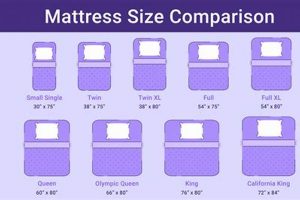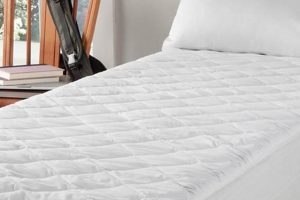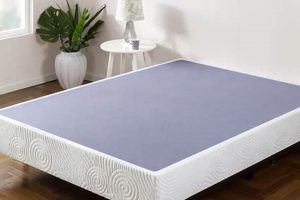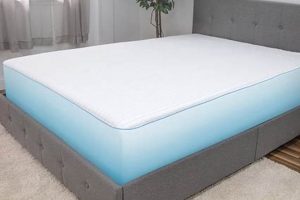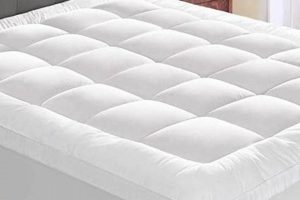The dimensions of a twin extra-long bed are standardized at 38 inches wide and 80 inches long. This specific size provides additional length compared to a standard twin, making it suitable for taller individuals or those who prefer more legroom.
This mattress configuration is particularly common in college dormitories and other institutional settings due to its space-saving width and accommodating length. The extended length improves sleep comfort and is also useful for guest rooms or smaller bedrooms where maximizing space is a priority. The proportions strike a balance between compactness and usability for a single sleeper.
Understanding the precise measurements allows for accurate selection of bed linens, bed frames, and other accessories. Consideration of these dimensions ensures proper fit and optimal functionality of the sleeping arrangement.
Twin XL Mattress Considerations
Optimizing space and comfort requires careful attention to mattress dimensions. The following tips facilitate informed decisions regarding its use and upkeep.
Tip 1: Measurement Verification: Always confirm actual measurements before purchasing bed frames or linens. Slight variations may exist between manufacturers.
Tip 2: Fitted Sheet Accuracy: Ensure fitted sheets are specifically designated as “Twin XL” to prevent looseness or difficulty in fitting. Standard twin sheets will not suffice.
Tip 3: Room Dimensions: Assess bedroom dimensions before purchase. This size occupies a larger footprint than a standard twin, impacting available space.
Tip 4: Frame Selection: Choose a bed frame that is designed explicitly for the measurements. Using an undersized frame can lead to mattress damage or instability.
Tip 5: Longevity Considerations: Rotate the sleeping surface regularly. This practice promotes even wear and extends the lifespan of the mattress.
Tip 6: Storage Solutions: Integrate under-bed storage options to maximize space efficiency in smaller rooms. Select containers that accommodate the frame’s height.
Adhering to these guidelines promotes longevity, optimizes comfort, and ensures proper utilization within a given living space.
The following sections will discuss related bedding options and considerations.
1. Width
The specification of a 38-inch width is a defining characteristic that differentiates the twin extra-long from other mattress dimensions. This measurement dictates spatial requirements and impacts user suitability.
- Spatial Planning Implications
The 38-inch width directly influences room layout and furniture arrangement. Accurate understanding of this dimension enables architects and interior designers to optimize living spaces, particularly in environments where space is constrained, such as dormitories or small apartments. Incorrectly estimating this width can lead to inefficiencies in space utilization.
- Compatibility with Bed Frames
A bed frame intended for a twin XL requires precise adherence to the 38-inch width specification. Deviations from this measurement can result in an unstable or improperly supported mattress, compromising structural integrity and potentially leading to premature wear and tear. Strict adherence to this dimension is crucial for safe and effective use.
- Impact on Sleep Comfort
While the length of a twin XL addresses height accommodation, the 38-inch width provides a defined sleeping surface. Individuals who require more lateral space may find this dimension restrictive, leading to potential discomfort or compromised sleep quality. Consideration of personal sleep preferences and body size is paramount when evaluating suitability.
- Textile and Accessory Selection
Linens, mattress protectors, and other accessories designed for a twin XL mattress must conform to the 38-inch width. Standard twin-sized items are generally incompatible, resulting in improper fit and reduced functionality. Careful attention to product specifications ensures proper alignment and optimized performance.
In conclusion, the 38-inch width is an indispensable element in defining the size and functionality. Its impact extends beyond a simple measurement, influencing spatial planning, equipment compatibility, user comfort, and accessory selection. Understanding the precise implications of this dimension is crucial for informed decision-making regarding mattress selection and utilization.
2. Length
The 80-inch length specification is a primary attribute defining the twin extra-long configuration. Its role is pivotal in addressing the needs of taller individuals and differentiating it from standard twin mattresses.
- Accommodation of Taller Individuals
The 80-inch length directly correlates with the comfort level experienced by taller sleepers. A standard twin, generally shorter, may result in discomfort due to insufficient legroom. This extended length is a critical factor in promoting proper spinal alignment and mitigating pressure points, contributing to overall sleep quality. For example, an individual measuring 6 feet (72 inches) benefits significantly from the additional length compared to a shorter alternative.
- Institutional and Dormitory Applications
Educational institutions and dormitories frequently employ this dimension due to its space efficiency and ability to accommodate a diverse range of student heights. The standardized length simplifies logistical considerations, such as bedding procurement and room layout planning. The consistent use of this specific length promotes uniformity and cost-effectiveness in large-scale applications.
- Impact on Bedding Selection and Fit
The precise 80-inch length mandates the use of specifically labeled “Twin XL” bedding. Standard twin sheets are inadequate and will not properly fit the sleeping surface. Choosing the appropriate bedding ensures a secure fit, prevents slippage, and maintains a tidy appearance. Neglecting this aspect can lead to discomfort and reduced functionality of the sleep system.
- Influence on Overall Sleep Experience
The increased length of a twin extra-long mattress directly impacts the overall sleep experience by providing greater freedom of movement and reducing the likelihood of physical constraints during sleep. This is especially beneficial for individuals who tend to shift positions frequently during the night. The added length mitigates disruptions caused by physical limitations, fostering a more restful and uninterrupted sleep cycle.
In summary, the 80-inch length is integral to the purpose and function. It directly addresses the needs of taller individuals, streamlines operations in institutional settings, dictates bedding compatibility, and contributes to improved sleep quality. Understanding its significance is crucial for making informed decisions related to mattress selection and usage.
3. Common Uses
The prevalence of twin extra-long mattresses in dormitory settings stems from a confluence of factors related to space efficiency, standardization, and the accommodation of a diverse student population. The inherent size characteristics directly address the unique demands of dormitory environments.
- Space Optimization in Shared Living Spaces
Dormitory rooms are often limited in square footage, necessitating furniture choices that maximize usable space. The relatively narrow width of the twin extra-long allows for multiple beds to be placed within a room without unduly restricting movement. For instance, a room accommodating two students can more easily incorporate other essential furnishings, such as desks and storage units, compared to configurations utilizing larger mattresses.
- Standardization for Logistical Efficiency
Educational institutions benefit from standardized mattress sizes for ease of procurement, inventory management, and linen provision. Using a consistent mattress dimension, such as the twin extra-long, simplifies the process of ordering and distributing bedding, reducing logistical complexities and associated costs. This uniformity ensures operational efficiency across the entire dormitory system.
- Accommodation of Varying Student Heights
The extended length provides a crucial advantage in dormitory settings where occupants represent a wide range of heights. While a standard twin might prove inadequate for taller students, the additional length of the twin extra-long ensures comfortable accommodation for a larger proportion of the student population. This reduces the need for specialized mattress requests and promotes inclusivity within the living environment.
- Durability and Practicality Considerations
Dormitory mattresses are subjected to significant use and potential wear and tear. Twin extra-long mattresses, often constructed with durable materials, are chosen for their ability to withstand the demands of institutional settings. Their standardized dimensions facilitate easier replacement and maintenance, ensuring the continued functionality of the sleeping arrangements over extended periods.
In summary, the widespread use of twin extra-long mattresses in dormitories is not arbitrary but rather a deliberate choice driven by practical considerations related to space constraints, logistical streamlining, student accommodation, and durability requirements. The specific dimensions offer a balanced solution for meeting the diverse needs of these environments.
4. Benefits
The association between legroom and twin extra-long mattresses is a direct consequence of the mattress dimensions, specifically the 80-inch length. This attribute provides enhanced comfort for individuals exceeding the average height, alleviating potential discomfort caused by restricted leg extension. Without sufficient length, limbs may extend beyond the mattress edge, disrupting sleep and potentially leading to postural issues. The increase in dimension directly addresses the needs of a specific user group: taller people.
Institutions such as universities, where dormitory furnishings must accommodate a diverse range of student statures, exemplify the practical significance of legroom benefits. By providing twin extra-long mattresses, these institutions minimize complaints related to inadequate sleeping space, thereby promoting student well-being and satisfaction. Similarly, hotels targeting business travelers or athletes recognize the value of offering beds that cater to individuals of varying heights, ensuring a comfortable and restful experience. The impact of this specific feature reverberates through improved rest and recuperation.
In summary, the availability of legroom is not merely a secondary characteristic of a twin extra-long mattress but a crucial component directly linked to its purpose and design. The increased length effectively addresses the ergonomic needs of taller individuals, leading to improved sleep quality and physical well-being. Overlooking this connection would diminish understanding of the distinct advantages this specific size offers relative to standard twin mattresses.
5. Alternatives
A standard twin mattress represents the most direct alternative when considering a twin extra-long. Understanding the dimensional differences and practical implications is crucial for informed decision-making based on individual needs and spatial constraints.
- Dimensional Discrepancy: Length
The primary distinguishing factor lies in length. A standard twin typically measures approximately 75 inches in length, compared to the 80 inches of a twin extra-long. This seemingly small difference of 5 inches is significant for individuals of taller stature, impacting legroom and overall sleep comfort. Selecting a standard twin for a taller person may result in discomfort due to insufficient support.
- Suitability for Children and Smaller Adults
The reduced length of a standard twin often makes it a more appropriate choice for children and smaller adults. The shorter dimension is adequate for their physical needs and allows for more efficient use of space in smaller bedrooms. Conversely, using a twin extra-long in such scenarios might be unnecessary, leading to wasted space without any appreciable benefit.
- Cost Considerations and Bedding Availability
Standard twin mattresses and related bedding accessories are generally more readily available and often less expensive than their twin extra-long counterparts. This cost differential can be a significant factor for budget-conscious consumers, particularly when furnishing multiple rooms, such as in a family home or a short-term rental property. Ease of access to bedding and competitive pricing contribute to the practicality of the standard twin.
- Spatial Efficiency in Compact Environments
In extremely compact environments, the slightly shorter length of a standard twin can provide a crucial advantage. Even a few inches of saved space can significantly improve room layout and facilitate the incorporation of other essential furnishings. This consideration is especially relevant in situations where maximizing every square inch is paramount, such as in studio apartments or shared living spaces.
The choice between a standard twin and a twin extra-long is not merely a matter of personal preference but depends on a careful evaluation of individual height, budgetary limitations, spatial constraints, and accessibility of bedding options. A thorough understanding of these factors is crucial for selecting the option that best aligns with specific needs and circumstances.
Frequently Asked Questions
This section addresses common inquiries regarding the dimensions and applications of twin extra-long mattresses.
Question 1: What are the precise measurements?
The standardized measurements are 38 inches in width and 80 inches in length. Deviations are generally minimal but should be verified prior to purchasing bedding or frames.
Question 2: Is a twin XL the same as a standard twin?
No, the primary difference is length. A standard twin is shorter, typically measuring 75 inches. The extended length offers added legroom.
Question 3: What type of bedding is required?
Bedding specifically labeled “Twin XL” is necessary to ensure a proper fit. Standard twin sheets will be too small.
Question 4: Are these mattresses suitable for adults?
Yes, particularly for taller adults. The extra length accommodates individuals who may find standard twin beds too short.
Question 5: Where are these mattresses commonly found?
Dormitories, college residence halls, and guest rooms are typical locations. The dimensions balance space efficiency with accommodating length.
Question 6: What is the weight capacity of this mattress type?
Weight capacity varies depending on the specific construction and materials used. Refer to the manufacturer’s specifications for detailed information.
Understanding these details ensures appropriate selection and utilization. Neglecting these details can result in discomfort and improper use.
The subsequent section delves into the material composition and construction considerations.
Defining Dimensions, Defining Comfort
The preceding discussion clarifies “what is the size of a twin xl mattress” and underscores its importance. The specified dimensions, 38 inches by 80 inches, are not arbitrary but are engineered to meet specific needs, namely the accommodation of taller individuals and the efficient utilization of space in settings like dormitories. The choice between this configuration and alternatives, such as a standard twin, hinges on individual requirements and logistical considerations.
Understanding the measurements is crucial for ensuring optimal sleep quality and efficient resource allocation. Accurate awareness allows for informed purchasing decisions regarding bedding and frames, leading to prolonged product lifespan and improved user satisfaction. Continued diligence in considering these measurements will contribute to informed choices and enhanced well-being.


